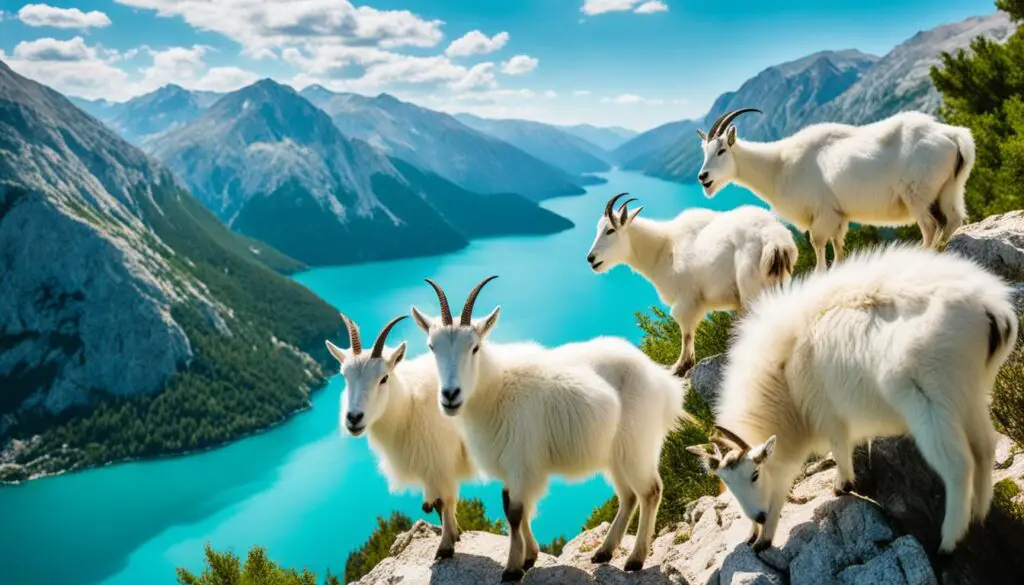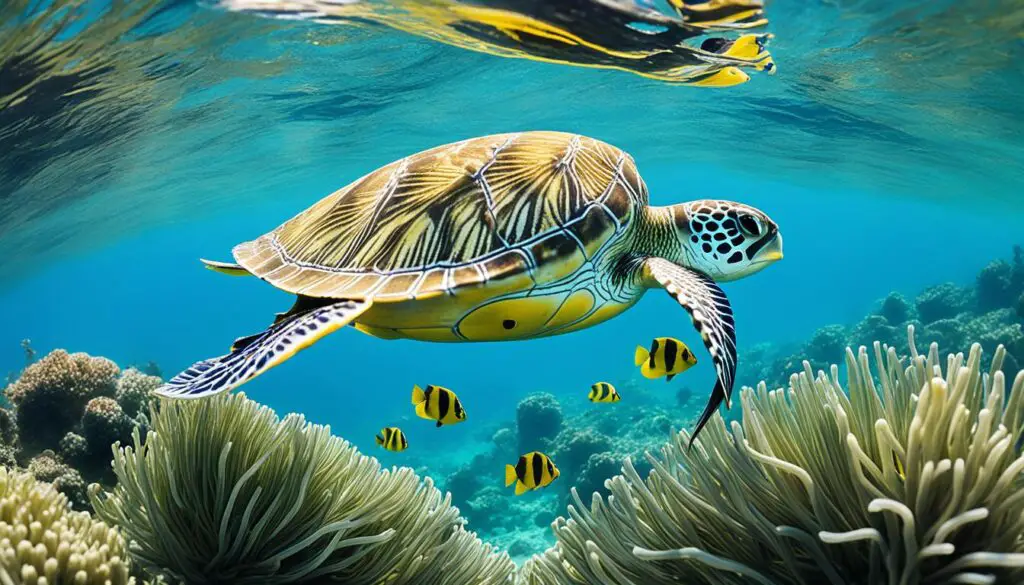Did you know that Montenegro, the smallest Balkan nation in terms of population and land mass, is home to a fascinating array of wildlife? From majestic brown bears roaming the mountainous regions to a variety of marine animals along the scenic coastline, Montenegro boasts a diverse fauna that captures the imagination.

Key Takeaways:
- Montenegro is home to a diverse range of wildlife
- The country’s geography includes mountainous forests and a stunning Mediterranean coastline
- Specific data on Montenegro’s fauna is limited due to the concentration of wildlife in unpopulated areas
- Efforts are underway to protect endangered species and increase public awareness of conservation practices
- Montenegro’s unique and diverse fauna is a valuable asset that requires preservation and sustainability
Mammals in Montenegro
Montenegro’s mountainous regions in the north are home to a variety of mammals. The area is known to have a population of brown bears, with less than 130 individuals estimated to be living in the wild. Other carnivores such as wolves and Balkan lynxes also inhabit the virgin forest, although they tend to stay away from urban areas. The Balkan lynx is critically endangered and efforts are being made to protect the species from extinction. The golden jackal, a wild dog species, is also present in Montenegro. Domesticated mammals such as rabbits and livestock are found in agricultural areas.
Large Carnivores in Montenegro
| Species | Population | Status |
|---|---|---|
| Brown Bear | Less than 130 individuals | Endangered |
| Wolf | Unknown population size | Not evaluated |
| Balkan Lynx | Less than 50 individuals | Critically endangered |
Other Mammals in Montenegro
- Golden Jackal
- Rabbit
- Livestock (cattle, sheep, goats)
The brown bears in Montenegro are an iconic species, representing the large animals that inhabit the country’s mountainous regions. Efforts are being made to protect these magnificent creatures and ensure their survival in the wild.
Reptiles and Amphibians in Montenegro
Montenegro is home to a diverse range of reptiles and amphibians. The country boasts a total of 56 different species, including some unique and fascinating creatures. One notable reptile species found in Montenegro is the nose-horned viper (Vipera ammodytes), which is renowned as the most venomous snake in Europe. This viper is characterized by its distinctive horn-like projection on the tip of its nose. Its venom poses a significant threat to humans and other animals.
Another remarkable amphibian species found in Montenegro is the olm (Proteus anguinus). Also known as the “human fish,” this small aquatic creature is found in mountain cave systems, particularly within the karstic caves of the Dinaric Alps. The olm is unique due to its adaptations to the underground environment, such as its pale, translucent skin and its ability to survive without food for long periods.
The region’s caves and sinkholes provide essential habitats for a range of endemic reptiles and amphibians adapted to these unique conditions. These endemic species are found exclusively in Montenegro and are vital contributors to the country’s biodiversity. Other reptiles and amphibians found in Montenegro include the Italian crested newt, blue lizard, and various species of viper snakes.
Endemic Reptiles and Amphibians in Montenegro
| Species | Scientific Name | Status |
|---|---|---|
| Nose-Horned Viper | Vipera ammodytes | Not evaluated |
| Olm | Proteus anguinus | Near threatened |
| Italian Crested Newt | Triturus carnifex | Near threatened |
| Blue Lizard | Lacerta trilineata | Least concern |
| Viper Snakes | Various species | Different conservation statuses |

Birds in Montenegro
Montenegro is a bird enthusiasts’ paradise, boasting a rich diversity of avian species. Over 350 bird species have been recorded in the country, making it a significant hotspot for birdwatching and research.
One of the factors contributing to Montenegro’s abundant birdlife is its location along the Adriatic flyway. This migration route, stretching along the eastern coast of the Adriatic Sea, attracts a wide variety of bird species, including both migratory and resident birds.
While specific data on the most common bird species in Montenegro is limited, the country’s diverse habitats, including coastal wetlands, forests, and mountainous areas, provide favorable conditions for numerous bird species to thrive.
However, despite the abundance of bird species, bird populations in Montenegro face threats, particularly from hunting activities, especially along the coastline. This poses a significant risk to both migratory and resident birds.
Many bird species in Montenegro rely on the marine biodiversity of the Adriatic Sea and the country’s coastal wetlands for food and habitat, making conservation efforts crucial to their survival.
Threatened Bird Populations in Montenegro
Several bird species in Montenegro are categorized as threatened according to the International Union for Conservation of Nature (IUCN). These include:
- Pygmy cormorant (Phalacrocorax pygmaeus)
- Greater spotted eagle (Clanga clanga)
- Dalmatian pelican (Pelecanus crispus)
- White-headed duck (Oxyura leucocephala)
Conservation efforts, both within Montenegro and through international collaborations, are crucial to ensure the protection of these threatened bird populations and their habitats.
Marine Animals in Montenegro
Montenegro’s picturesque coastline and pristine lakes are teeming with a diverse array of marine animals. The country’s proximity to the Adriatic Sea makes it an ideal habitat for various species, including enchanting dolphins and majestic sea turtles.

Dolphins in Montenegro
The Adriatic Sea, which embraces the Montenegrin coast, is home to two prominent dolphin species – the striped dolphin and the bottle-nose dolphin. These magnificent marine mammals can often be spotted swimming gracefully in the crystal-clear waters, captivating locals and visitors alike.
Sea Turtles in Montenegro
Montenegro’s sector of the Adriatic Sea is also a sanctuary for sea turtles. The region provides a vital nesting ground for three known species – the loggerhead turtle, green turtle, and the critically endangered Kemp’s ridley turtle. These remarkable creatures play an essential role in maintaining the delicate balance of the marine ecosystem.
The conservation efforts focused on protecting marine animals, such as dolphins and sea turtles, ensure the preservation of Montenegro’s rich biodiversity. These initiatives are vital for sustaining the delicate ecological equilibrium.
Additionally, the Bojana Estuary, located on the border between Montenegro and Albania, plays a significant role in supporting the thriving marine life. It serves as a crucial breeding ground for various species of mollusks and other economically significant marine organisms, contributing to the local fishing industry.
History of Wildlife in Montenegro
Excavations in Northern Montenegro have revealed fascinating insights into the ancient wildlife that once roamed the region during the Pleistocene era. These excavations have unearthed a treasure trove of fossils, providing valuable evidence of the diverse fauna that inhabited Montenegro and Eurasia millions of years ago.
Among the extraordinary discoveries are fossils of forest elephants, magnificent creatures that once roamed the ancient landscapes of Montenegro. These forest elephants were ancestors of the modern-day elephants that still exist today. The fossils of Stephanorhinus, ancestors of rhinoceros, have also been found, shedding light on the prehistoric rhinoceros species that once thrived in Montenegro.
Furthermore, the excavation sites have yielded remnants of a large hyena, providing a glimpse into the past predator-prey dynamics of the Pleistocene era. Additionally, evidence of a saber-toothed cat has been uncovered, revealing the existence of a formidable predator that once roamed Montenegro’s ancient wilderness.
These remarkable findings suggest that Montenegro was once home to a thriving ecosystem of large fauna, contributing to the rich biodiversity in the region during the Pleistocene era.
These extraordinary fossils provide invaluable insights into the history of wildlife in Montenegro, allowing scientists and researchers to reconstruct the ancient ecosystems that existed millions of years ago. By studying these fossils, experts can better understand the evolutionary history of various animal species and their interactions within the environment.
While the Pleistocene era may be long gone, the remnants of this ancient wildlife continue to captivate and inspire us, serving as a testament to the enduring wonder and diversity of Montenegro’s natural heritage.
Threats to Montenegro’s Ecosystem
Montenegro’s unique ecosystem faces various threats that pose a risk to its ecological balance and biodiversity. These threats include coastal pollution, hunting, logging, and the introduction of invasive species. Insufficient government resources and a lack of public awareness further exacerbate the challenges in addressing these issues.
Coastal Pollution
- Polluted water and discharges from boats pose a significant threat to Montenegro’s coastal regions. These pollutants can harm marine life, disrupt ecosystems, and degrade the overall water quality.
- The release of chemicals, sewage, and oil spills can have devastating effects on the delicate coastal habitats and the organisms that depend on them.
Hunting
Hunting practices in Montenegro contribute to the degradation of the ecosystem and endanger local wildlife populations.
- Unregulated hunting can disrupt natural predator-prey dynamics, leading to imbalances within the ecosystem.
- Overhunting of certain species can cause their populations to decline, disrupting the ecological equilibrium and potentially leading to the extinction of some species.
Logging
Unregulated logging poses a significant threat to Montenegro’s forests and natural habitats.
- Excessive logging can lead to deforestation, which not only destroys habitats but also contributes to soil erosion and the disruption of important ecological processes.
- The loss of trees can have cascading effects on other organisms that depend on them for food, shelter, and other resources.
Invasive Species
The introduction of invasive species can have far-reaching consequences for Montenegro’s native flora and fauna.
- Invasive species often outcompete native species for resources, leading to a decline in biodiversity and potential ecosystem disruptions.
- These non-native species can also alter habitats, disrupt food chains, and threaten the survival of native species.
Addressing these threats requires concerted efforts from the government, environmental organizations, and the public. Increased regulation and enforcement, the implementation of conservation measures, and the promotion of sustainable practices are crucial steps toward preserving Montenegro’s ecosystem for future generations.
Conclusion
Montenegro’s diverse wildlife is a valuable asset that requires urgent attention for its protection and conservation. The country’s unique geography and varied ecosystems provide habitats for a wide range of species, including endangered ones such as the brown bear and Balkan lynx.
Conservation efforts are underway to safeguard these iconic animals and their natural habitats. Government entities, in collaboration with environmental organizations, are implementing initiatives to increase public awareness about the importance of wildlife conservation and promote sustainable practices.
Preserving Montenegro’s rich biodiversity requires a collective effort from all stakeholders. By supporting and participating in conservation programs, the public can contribute to the long-term sustainability of Montenegro’s wildlife. Together, we can ensure that future generations can continue to appreciate and enjoy the beauty of Montenegro’s unique and diverse fauna.
